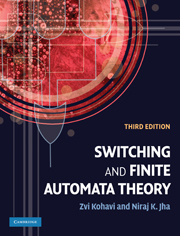Book contents
- Frontmatter
- Contents
- Preface
- Part 1 Preliminaries
- Part 2 Combinational logic
- 3 Switching algebra and its applications
- 4 Minimization of switching functions
- 5 Logic design
- 6 Multi-level logic synthesis
- 7 Threshold logic for nanotechnologies
- 8 Testing of combinational circuits
- Part 3 Finite-state machines
- Index
4 - Minimization of switching functions
from Part 2 - Combinational logic
Published online by Cambridge University Press: 05 June 2012
- Frontmatter
- Contents
- Preface
- Part 1 Preliminaries
- Part 2 Combinational logic
- 3 Switching algebra and its applications
- 4 Minimization of switching functions
- 5 Logic design
- 6 Multi-level logic synthesis
- 7 Threshold logic for nanotechnologies
- 8 Testing of combinational circuits
- Part 3 Finite-state machines
- Index
Summary
A switching function can usually be represented by a number of expressions. Our aim in this chapter will be to develop procedures for obtaining a minimal expression for any such function, after establishing some criteria for minimality. In the preceding chapter, we dealt with simplification of switching expressions by means of algebraic manipulations. The deficiency of this method is that it does not constitute an algorithm and is ineffective for expressions of even a small number of variables (e.g., four or five). The methods to be introduced in this chapter partly overcome these limitations. The presented map method is very effective for the simplification by hand of expressions of up to five or six variables, while the tabulation procedure is suitable for machine computation and yields minimal expressions.
Introduction
Our aim in simplifying a switching function f(x1, x2, …, xn) is to find an expression g(x1, x2, …, xn) which is equivalent to f and which minimizes some cost criteria. There are various criteria to determine minimal cost. The most common are:
the minimum number of appearances of literals (recall that a literal is a variable in complemented or uncomplemented form);
the minimum number of literals in a sum-of-products (or product-of-sums) expression;
the minimum number of terms in a sum-of-products expression, provided that there is no other such expression with the same number of terms and fewer literals.
- Type
- Chapter
- Information
- Switching and Finite Automata Theory , pp. 67 - 107Publisher: Cambridge University PressPrint publication year: 2009

